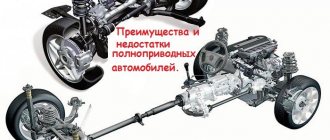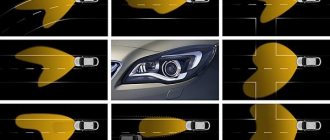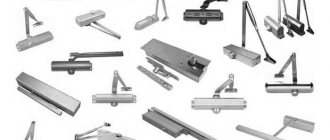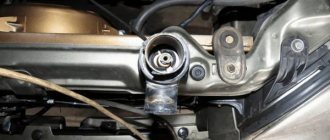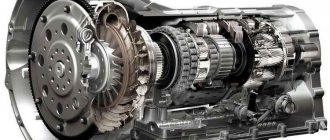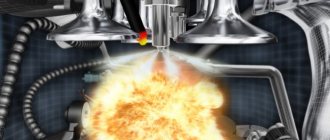The Electronic Stability Program (ESP) is designed to stabilize the vehicle in difficult situations and prevent skidding. During maneuvers, it helps to avoid lateral slipping.
Have you ever needed the help of a car lawyer?
Not really
Since 1959, many manufacturers have developed and attempted to introduce stability control devices. However, due to the lack of developed technologies, they were either ineffective or turned out to be cumbersome and required too many resources to operate.
The first effective stability control system was developed jointly by Mercedes-Benz and Bosch. As conceived by the developers, it was called ESP (Elektronisches Stabilitatsprogramm) and they began to equip premium cars with it.
Today, depending on the manufacturer and purpose, the device has several names or is designated by different abbreviations.
Operating principle
The main task of the device is to timely catch the moment of uncharacteristic movement of the car. To achieve this, the intake sensors continuously transmit information about the current movement of the vehicle. The received data is compared with standard options embedded in the controller. If any deviation from the set program is noted, the device turns on.
Depending on the situation, ESP affects the braking device or the torque.
The program provides a lot of options for the development of events and actions to prevent emergency situations.
When skidding
If during a left turn the car does not fit into a safe trajectory, the device instantly affects the right front wheel. The braking system will be activated, which will lead to the skid being extinguished. The method is based on the laws of physics. The braking right wheel acts as a counteraction and stabilizes the situation.
During demolition
When drifting during a left turn, ESP activates additional torque by braking the left rear wheel. The system’s actions are aimed at anticipating the situation. The driver may not even feel interference in the control process, not suspecting that he made a mistake while driving the car.
Design and principle of operation of the ESP System
In an effort to make a car not only fast, but also safe, manufacturers, since the middle of the last century, began to develop systems that allow for control over the car in any conditions. One of these ESP is the exchange rate stability system or vehicle dynamic stabilization system. Under this name a whole orchestra of functions of various systems is united.
The ESP system includes: the standard brake system, engine management system, ABS system, electronic sensors that read wheel speed and rotation, steering wheel position and brake pressure. Each brand calls this set differently: ESC, VDC, VSC, DSC, DSTC, etc., but the essence is the same. The main task of the ESP exchange rate stability system is to ensure that the car moves along a strictly specified trajectory without skidding and “yaw” along the road.
How does the ESP system work? When driving a car, the driver sets the trajectory of movement by turning the steering wheel. Electronic sensors read the information and transmit it to the on-board computer, which, by regulating the pressure in the brake cylinders of the wheels, begins to slow down the wheel that can provoke a skid. If this is not enough, the system reduces engine speed, reducing traction on the drive wheels, thereby correcting driver errors.
If the system has not been turned on, one of the wheels may begin to slip while driving in slippery areas. And if you don’t pay attention to this, the car will skid with all the ensuing consequences. However, there are quite a few cases when the ESP system does not help. For example, if you are stuck in snow, mud or sand, then ESP will only get in the way. And in order to leave, you need to turn it off.
Is it possible to install an ESP system on a car that was originally produced without it? To do this, you need a new hydraulic unit, missing parts, and most importantly, access to the control unit programs. The floor of the car will have to be redone. In general, this is almost impossible.
What about new cars? When obtaining a certificate for a car in the Russian Federation, the presence of an ESP system is a prerequisite. This rule was introduced in January 2020, and, in my opinion, it was done very correctly. By the way, it applies to all new cars, both domestic and imported.
But, unfortunately, the ESP system is not a panacea, especially for those drivers who love speed and adrenaline because it is not designed for extreme conditions. In general, I would like all systems responsible for safety: both active and passive, to be mandatory in the database of any class of car.
And in conclusion, I suggest watching a video of how the ESP system works:
SIMILAR ARTICLES:
Correctly adjusting the rear view mirrors
Driver Alert System Today: Promising Technologies for the Future
Features of winter diesel fuel
How to choose the right driver's seat
Which suspension to choose when choosing a car?
Car dashboard functions
What is the drive of a car?
Pros and cons of a four-wheel drive vehicle
Types, meaning and features of operation of automobile filters
Catalyst and its role in the exhaust system
What is “facelift” and “restyling”?
Pros and cons of the system for recognizing pedestrians and other obstacles
Ran-Flat technology: advantages and disadvantages
What does “improved gasoline” mean?
Self-driving cars will soon appear on our roads!
How a Ford design is created
Pros and cons of a CVT gearbox
Car batteries: what and how best to charge them?
Mandatory availability of ESP
Since 2011, the United States and European Union countries have legislated that every car must be equipped with Elektronisches Stabilitatsprogramm. There is no such condition in Russian legislation. In the Russian Federation, the presence of a control device is perceived as an additional option. However, this does not make ESP any less necessary or useful.
Installing ESP on old cars is too expensive and not necessary. New foreign cars and domestically produced cars must be equipped with ESP in order to receive a European certificate of conformity.
Therefore, despite the absence of direct legislative acts, since 2015, most new Russian-assembled cars are equipped with a stability control system.
Electronic components of the device
Electronic stability control uses ABS and traction control, as well as several dedicated sensors, to do its job.
ABS system
Before the 1990s, the driver had to press the brake pedal very hard to maintain brake lock and cause deceleration. With the invention of anti-lock brakes, driving safely has become much easier. ABS with an electronic pump brakes faster than the driver himself, thereby causing understeer or oversteer. ESP uses a device to correct the problem by activating ABS, as needed, for an individual wheel.
Traction control system
ESP also uses traction control for driving safety. While it is responsible for monitoring side-to-side movement around a vertical axis, traction control is responsible for forward-backward movement. When the traction control detects wheel slip, the electronic stability control sensor acts on one side.
In the video - what is ESP of a car:
The device works quite dynamically - information is supplied to the car’s central computer using three types of sensors:
- Wheel speed sensor. Such sensors are located on each wheel and measure the speed in motion, the computer compares it with the speed of the engine.
- Steering angle sensors. These sensors are located in the steering column and measure the direction the driver takes while driving.
- Angular velocity sensor . Located in the middle of the car and measures the movement from side to side of the car.
Is it possible to install it yourself?
Installing an ESP is a very labor-intensive process.
Installing an ESP is a labor-intensive process. To do this you will need to purchase expensive parts. In addition, a new hydraulic unit will be needed. To install the ESP, you need to have access to the control unit. You will also need knowledge of the configuration features of the programs installed in it.
To install the device, you will have to disassemble and re-equip most of the machine. A driver, even one who has experience in repairing a car on his own, cannot handle such a task. If necessary, the work is entrusted to specially trained specialists.
Additional Stability Control Features
ESP has various functions, the presence of which, perhaps, even informed motorists are not aware of. They are also called software extensions.
List of additional features:
- Removing moisture from disks . This function removes moisture at speeds above 50 km per hour. At the same time, the windshield wipers operate. How does this feature work? The control unit slightly increases the pressure in the circuit. The pads are pressed against the steel disc. The moisture evaporates effectively in a few minutes.
- FadingBrakeSupport . This technology significantly increases the efficiency of the braking system when heated. FadingBrakeSuppor technology increases the pressure in the so-called brake actuator. This helps prevent insufficient adhesion between the brake discs and pads.
- Stabilization of the “road train” . The stabilization function is intended for vehicles that are equipped with some kind of trailer (TSU). This optional feature can reduce torque and control the vehicle's braking system. This prevents trailer yaw.
- BrakingGuard. This is a collision avoidance function. The additional BrakingGuard function is implemented in cars that have cruise control.
- RollOverPrevention . This feature helps prevent tip-over. RollOverPrevention stabilizes the movement of the machine when there is a threat of rollover.
ESP malfunctions and solutions to problems
Breakdowns and malfunctions of the device will be indicated by a warning light located on the instrument panel. Reasons for the lamp to operate include:
- Damage or breakage of the wire of any of the sensors;
- brake sensor failure;
- malfunctions of the electronic unit;
- failure of the ESP block brushes.
ESP is a complex device. Attempts to repair it yourself often end in complete failure of the system.
If a malfunction is detected, the vehicle is taken to a service station. Service workers will conduct computer diagnostics of the machine and determine the causes of problems. Subsequently, after discussing solutions with the owner, the problem will be eliminated.
What does Electronic Stability Program (ESP) mean?
Every motorist knows what ESP is. It is often also called “anti-skid” and “anti-skid”.
ESC is a dynamic stabilization system that ensures machine stability. It significantly improves driving safety. Therefore, ESP is one of the most popular security systems.
It can identify and eliminate critical situations in advance. For example, to maintain the controllability of the car.
It includes other machine systems:
- ASR;
- EDS;
- EBD;
- ABS.
Let's look at the main advantages:
- increased grip;
- maximum stability;
- easier control on various surfaces;
- increased safety.
BAS system
1. Purpose.
Among the auxiliary systems of modern cars, one cannot fail to mention the Brake Assist System, or BAS for short. This system is an algorithm that provides assistance in case of emergency pressing of the brake pedal. Compared to the system discussed above, BAS is more simple to operate. Its task is to assist the driver and “squeeze” the maximum out of the vehicle’s braking system.
The following situation can be given. The driver cannot “push” the brake to the limit (for example, the pedal is pressed too poorly or a bottle has fallen under it). As a result, the brake system worked, but not 100 percent. With a BAS system, the “brains” do everything independently and give the command to increase the braking speed.
The peculiarity of the Brake Assist System is that it operates completely automatically and is independent of the driver’s actions. The electronics analyze when it is necessary to assist the driver and strengthen the action of the brakes. In this case, the decision is made after analyzing information from a whole group of different sensors.
2. History of appearance.
The history of the appearance of this algorithm, which was created as an auxiliary system for standard ABS, deserves special attention. The first “swallows” on cars appeared in the early 70s of the last century. The pioneer was the car.
At the present stage, everything has changed. If previously the Brake Assist System was installed only on expensive cars and was presented as an exclusive algorithm, then at the present stage such systems are installed on almost all classes of cars. Thus, the Euro NCAP committee recently summed up the results of installing BAS systems on cars from different manufacturers. Almost immediately after this, it was decided to introduce this device as mandatory for installation. In particular, a car does not receive a five-star test for safety if it does not have such a system on board. Such a revolutionary innovation helped push manufacturers to create even safer and more efficient cars.
There is confidence that after some time, BAS systems will become mandatory and will be installed on all production models. Already today they are available on such popular cars as the Ford Focus or Chevrolet Aveo, the cost of which ranges from half a million to a million rubles. Despite the fact that previously such systems were installed only on Volvo or Mercedes cars.
3. Operating principle.
A special feature of the BAS system is its ability to work with different braking systems, both hydraulic and air. To recognize the situation, various measuring instruments are used (installed at different points of the car):
- sensor that controls wheel speed;
- a sensor that records the speed of movement of the amplifier rod; the task of this device is to record the force of pressing the accelerator pedal;
- a sensor that monitors the pressure level in the brake system; here the principle is similar to the previous device; the difference is that this unit is used for hydraulics, and not for a vacuum booster as in the previous case.
Based on its operating principle, BAS controls fluid pressure. It's easy to explain. The hydraulics are configured in such a way that the entire mechanism is controlled by a hydraulic drive. In this case, the brake pedal only transfers force from the foot to the brake system cylinder. Thanks to the pressure created, the piston begins to move, and the brake system mechanism begins to compress. The BAS algorithm controls the pressure of the brake fluid in the cylinders, adding or decreasing the force of the braking system.
4. Types.
Such systems are conventionally divided into several categories and may vary:
- by the number of sensors that are used to take readings;
- by functionality.
The most reliable systems are installed on Mercedes and BMW cars. The peculiarity of the products is that they take into account a number of factors - the condition of the road, the force on the brake pedal, the distance to the car moving in front, and so on.
If the car's main focus is on the pneumatic drive, then the compressed air is adjusted. The latter moves the piston and improves the quality of the brakes. This function is due to the ability to regulate air pressure.
How the DSC system works
To analyze the current situation and timely identify the first signs of a possible skid, this system uses the readings of many sensors and units:
- angular velocity obtained from 4 active sensors;
- steering angle;
- the speed at which the vehicle enters a turn;
- brake fluid pressure level;
- values of transverse and longitudinal acceleration;
- yaw angle;
- activation of the brake light, etc.
Thus, the system monitors not only the technical characteristics at a particular moment in time, but also the actions of the driver. This provides effective protection in a variety of driving styles and driving situations.
All this data is constantly transmitted to the DSC system's computer center and interpreted. The final result is compared with the reference value, which is stored in the device’s memory. If deviations go beyond acceptable limits, the system begins to take action to stabilize the vehicle's course.
It is important to note that DSC is not a hard limiter - it uses not only a specific reference model, but also a certain range of possible deviations.
Restoring optimal stability and grip is achieved as a result of a whole range of actions:
- the operating mode of the engine changes - first of all, the torque generated;
- the intensity of braking of individual wheels increases or decreases;
- if the car is equipped with active steering, then DCS can automatically change the angle of rotation of the wheels;
- On models with adaptive suspension, the damping in the struts is also adjustable.
Related article: How scammers use DVRs to extort money from drivers
One of the most important and difficult aspects of the DSC system is torque control. To achieve this, a whole range of measures are used:
- the position of the throttle valve varies;
- the intensity of fuel injection or the supply of impulses from spark plugs changes;
- the ignition timing changes temporarily;
- gear shifting in an automatic transmission is prevented;
- if the car is all-wheel drive, then the distribution of torque between its axles may change.
Another important function of the DSC system is maximum speed control. After reaching the specified limit, the system will send a signal to the ECU to reduce the torque.
